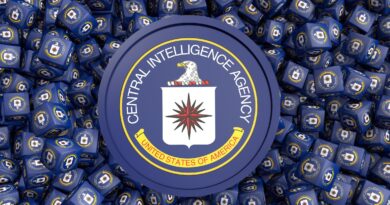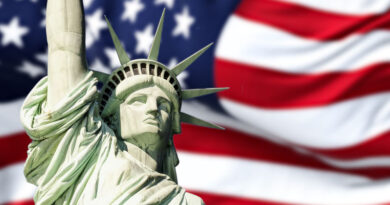The ‘deep state’: From scholarly critique to toxic conspiracy theory
By Dina Temple-Raston,
In Deep
The FBI, the CIA, and the Truth about America’s “Deep State”
By David Rohde
Norton. 323 pp. $30
To hear President Trump’s supporters tell it, there is a secret army of malcontents lurking deep within the bowels of government whose goal is to drive Trump from office. Think Eisenhower’s military industrial complex, but on steroids. It is referred to as the “deep state,” and two-time Pulitzer Prize winner and investigative journalist David Rohde went out in search of it. The result is a fascinating new book called “In Deep: The FBI, the CIA, and the Truth About America’s ‘Deep State.’ ”
In Rohde’s account, Trump became the first American president to apply the term “deep state” to the U.S. government, in 2017. As often seems to happen these days, it began with an accusation by retweet. The president forwarded to his 60 million followers a post by Fox News host Sean Hannity, in which Hannity accused the deep state of trying to reverse the 2016 election. From that moment on, the term became “part of the Trumpian lexicon, along with ‘witch hunt’ and ‘fake news,’ ” Rohde writes. “President Trump himself increasingly invokes the term. In 2019, Trump used the phrase as at least 23 times, twice the number he did in 2018.”
W. W. Norton
To be sure, Trump came to office primed to distrust the Washington establishment. He has a deep suspicion of civil servants held over from previous administrations, convinced that they are part of a vast Never Trump conspiracy. No less contentious was his relationship with the intelligence community and the FBI, which first raised concerns about his campaign’s links to Russia. No one, it appears, was immune from his suspicion.
Even Anthony Fauci, the nation’s top infectious-diseases expert, who has become America’s Doctor in the face of the coronavirus pandemic, has been accused of being a deep state actor. The notion went viral when Fauci put his hand in front of his face in a gesture interpreted as disbelief after the president referred to the State Department as “the Deep State Department.” Fauci then found himself in a fantastical narrative in which he was accused of exaggerating the virus’s threat to damage the economy and hurt the president’s reelection chances. (The doctor’s security detail has since been beefed up.)
How did we get here?
The idea of the deep state, Rohde writes, is inextricably linked to a particular view of presidential power. There is a contingent of conservatives who have long believed “that a powerful presidency, unhindered by aggressive oversight from Congress and the courts, was necessary in order to defend the country,” Rohde writes. “Their maximalist view of executive power remained largely on the fringes of American politics. It would gain greater currency during the Reagan administration, after the 9/11 attacks, and unexpectedly, when Donald Trump won the presidency in 2016 — forty years after the Church Committee completed its work.” (That committee had investigated the misdeeds of the FBI and the CIA in the late ’60s and had helped produce the reforms establishing congressional oversight of the agencies.)
The term “deep state” first appeared in the United States in a 2007 book, “The Road to 9/11,” by Peter Dale Scott. Scott, a retired University of California at Berkeley professor, accused the U.S. military of fueling conflict both inside and outside the country from the Cold War right up until the Sept. 11, 2001, attacks. In that context, the idea seemed to be fodder for a reasonable political discussion. It took conservative talk radio, Rohde writes, to add toxicity.
While promoting the book, Scott became an occasional guest on Alex Jones’s far-right radio program, and it was there that his discussion of the deep state began to be seen through a more conspiratorial lens. Rohde interviewed Scott and learned that “he regretted appearing on the show and was angered by how Jones and his audience have used the concept of a ‘deep state.’ ” Scott told Rohde, “They have vulgarized the term.”
The concept of the deep state popped up again in a Breitbart News article titled “The Deep State vs. Donald Trump,” shortly before Trump took office, Rohde reports. Writing under the pseudonym “Virgil,” the unnamed author defined the “ ‘deep state’ as all federal employees as well as their political supporters, the policy elite (the ‘chattering class’) and the mainstream media,” Rohde records, adding that the very idea that there is some secretive club working the levers of power taps into “Americans’ long-standing suspicions of government, particularly among conservatives.”
To explain how this came to be, Rohde begins with the Church Committee investigations of CIA and FBI overreach in the wake of Watergate. What the bipartisan committee found was that the two had been illegally investigating Americans for years.
“In a society that declared itself exceptional, democratic, and free, the violations of privacy and liberty were stunning,” Rohde writes. “The CIA secretly opened and photographed nearly a half-million letters mailed between private citizens in the United States, including the personal correspondence of John Steinbeck, Hubert Humphrey, and Richard Nixon. Agency operatives had secretly funded or infiltrated student groups, university centers, and foundations across the United States.”
The committee concluded that the abuses weren’t the work of a few rogue officers — they were institutional. Around this same time, a promising young student named William Barr had just graduated from Columbia University in New York and had joined the CIA as an intelligence analyst. He “questioned the aggressiveness of the congressional oversight,” Rohde writes, “later saying that the Church Committee delivered ‘body blows’ to the agency.”
Rohde contends that this marked the beginning of Barr’s antipathy for congressional oversight, which “he saw as excessive, inappropriate and, at times, comical. He told friends that he was appalled by the mediocrity of some members of Congress and the stupidity of their questions,” Rohde writes. “It was the first round in a lifelong war that Barr would wage against congressional oversight. For the next forty years, Barr would work to strengthen the power of the president.”
“In Deep” tracks Barr’s Zelig-like presence at key moments of executive power flexing. When President George H.W. Bush decided to send troops to Panama to arrest President Manuel Noriega, Barr was head of the Justice Department’s office of legal counsel. He issued a legal opinion finding that a president has an “inherent constitutional authority” to order the FBI to round up people in foreign countries.
“The opinion reversed an earlier Justice Department policy that the president lacked such authority and expanded executive branch power,” Rohde writes. “After seeking refuge in the Vatican diplomatic mission in Panama, Noriega was arrested by FBI agents and later tried and imprisoned in the United States. After 9/11, the seizure of foreign nationals overseas by the United States would be vastly expanded.”
For Rohde this is one part of the deep state equation. To go mainstream, the idea needed something less intellectual — it needed a story line, ideally a conspiracy, and it found one in two lethal confrontations between federal agents and heavily armed civilians in Ruby Ridge, Idaho, and Waco, Tex.
In the waning days of the Bush administration, in August 1992, federal marshals sought the arrest of a white supremacist named Randy Weaver, who was wanted for selling illegal sawed-off shotguns to an undercover agent. Weaver lived with his family in a remote cabin on Ruby Ridge in northern Idaho. An FBI sniper ended up killing a Weaver family friend and Weaver’s wife, Vicki.
Just months later, agents from the Bureau of Alcohol, Tobacco, and Firearms (ATF) surrounded a compound near Waco owned by the Branch Davidians, a religious cult. The leader of the group, David Koresh, was said to be illegally stockpiling weapons. When agents went to arrest him, he resisted, and a five-hour gun battle ensued.
Attorney General Janet Reno, eager to avoid a repeat of Ruby Ridge, told the FBI to end the standoff peacefully. That’s not what happened. After seven weeks of fruitless negotiations, “federal agents drove tanks and armored vehicles up to the sprawling complex, knocked holes in its walls and fired more than 300 tear-gas canisters inside it,” Rohde recounts. “Four hours after the operations began, fires broke out at three locations inside the structure. On live national television, as the prairie wind stoked the flames, the complex burned to the ground.”
Seventy-six Branch Davidians, including children, died in the fire. Twenty of them, including Koresh and several children, died of gunshot wounds to the head. Although investigations later found that Koresh and his followers had set the fires, Rohde writes, conspiracy theories began to fill in the gaps. The National Rifle Association called ATF agents “armed terrorists.” Steve Stockman, a Republican congressman from Texas, wrote an article in Guns & Ammo magazine that claimed the Clinton administration had staged the whole standoff to drum up support for the 1994 assault weapons ban. Militia groups started rumors that federal agents had intentionally killed children at Waco. There was a video, based on doctored footage, suggesting that the FBI armored vehicles had attacked the compound with flamethrowers.
“Twenty years after the Church reforms, the oversight mechanisms designed to create public trust and transparency in government — congressional hearings, criminal trials by juries, and news media reporting — were increasingly dismissed by large parts of the American public,” Rohde laments, adding that the growing partisan divide between Democrats and Republicans provided a perverse incentive to emphasize conspiracy theories; it allowed politicians to portray their opponents as extremists.
Which brings us back full circle to the deep state in the age of Trump, from the “birther movement” to conspiracy theories about Benghazi and authoritarianism and coverups.
Rohde takes readers through Trump’s uncanny ability to weaponize information: the name-calling, the attacks on the media, the dystopian inaugural speech, the demands of loyalty, the hollowing-out of government institutions large and small, the questioning of intelligence, the fanning of divisions in the military, and finally the allegations that the Obama administration spied on his campaign.
A former official told Rohde that Stephen Bannon specifically fed Trump conspiracy theories “to get the president to distrust the advice of career government officials who opposed Bannon’s policy goals.”
With all his reporting and research, Rohde comes to a conclusion that, borrowing slightly from W.C. Fields, news of the deep state has been greatly exaggerated. “Every modern American president has expressed distrust of career government officials in Washington,” he notes early in the book. “But no president had attacked the motives of career government officials as publicly or angrily as Trump. No president has so openly trafficked in conspiracy theories for political gain.”
Which ultimately brings us to where we are today — months into a pandemic with a faltering world economy and an uncertain future. After reading “In Deep,” one can’t help wondering how much Trump’s suspicion of and disdain for expertise and experience (and the so-called “policy elite”) has affected his response to the coronavirus. The sad policy question is: How many lives have been lost because of his belief in the deep state?
This article has been archived for your research. The original version from The Washington Post can be found here.


